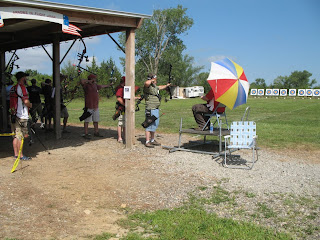This photograph is of the Grinter House, located in Kansas City, Kansas. Lyndy, Evan and I toured the house late last summer. It is on the National Register of Historic Places. The house was built by Moses and Annie Grinter in 1857 on a hillside on the north side of the Kansas River. The Grinters' story is just part of a very interesting local history of this region of northeast Kansas.
In the 1820's the United States began a policy of removing Indian tribes from places like the Ohio Valley and relocating them out "west". From roughly 1825 to 1845 more than 100,000 Native Americans were moved out of the developing eastern states. Approximately 10,000 of them were placed in Kansas. Many of the common Native American names in use around this part of the country do not reference the Indian tribes that were native to the area. A lot of the names refer to tribes that were part of this mass relocation. For example, the Shawnee tribe's ancestral homes were in Ohio, the Wyandot tribe came from what is now Ontario, Canada (their other name is the Huron tribe). During the 1830's many Native Americans from the Shawnee, Wyandot, and Delaware (also called Lenape) tribes were placed in the area around what today is Kansas City, Kansas. The nearby Fort Leavenworth military base was built partly to preserve the local peace between the Native Americans and the settlers.
A military road (for travel by the army, horses, wagons, stagecoaches, or those walking) ran from Fort Leavenworth south to Fort Scott, near the Missouri border in east central Kansas. Right at the point where the road crossed the Kansas River, in what today is part of Kansas City, Kansas, Moses Grinter established a ferry service. His ferry would have been essentially a large, flat, floating deck. Several horses, or a wagon or two, or troops would be ridden or loaded aboard, and then, using a rope that connected the two shorelines, the ferry would be pulled to the other side. A fare would be charged based upon what was being taken across.
Moses Grinter was born in Kentucky. I couldn't find much information about his early life, but he ended up in Kansas and met Annie Marshall. Annie was an Indian of the Delaware tribe. Her family had been relocated during the 1830's from New Jersey to northeast Kansas. Moses and Annie married and settled down to run the ferry service. Over time they prospered, and eventually left the ferry business and began operating a trading post. It was during this time that they built the Grinter house. It is located in a part of Kansas City, Kansas called Muncie. Where does the name Muncie come from? Muncie was one of the Delaware tribes, and they, too, were relocated to this part of Kansas during the 1830's.
The house is now part of the Kansas Historical Society and is officially called the Grinter Place State Historic Site. There are a couple of good webpages with more information it it. I like touring these old homes, and no two are ever alike. Moses hired a brick mason to build the house, a man named Bernard Tertling. Bernard was raised to be a brick builder, but he wanted to do something else. He tried his hand at farming, but gave up on that and sold it to open the first brewery in Kansas. It also failed, so by necessity he found himself returning to brick building and built this house for the Grinters. I took photos inside, but I am not posting any of them here, I don't want to spoil it for you. You'll just have to go see for yourself! As you might expect in an old house like this, everything in it is pretty much custom made just for this house.
Moses ended up living in the house more than 20 years, dying in 1878. Annie lived here for almost 50 years, until her death in 1905. Inside the nearby visitor's center there was a large old photograph of a big Grinter family reunion in the 1930's when descendants were still living there. As for the Native Americans that had been moved here in the 1830's, they were eventually sent packing again. In the 1860's, with railroad construction in full force, their land was needed and they were all relocated to the Oklahoma Territory.
Moses ended up living in the house more than 20 years, dying in 1878. Annie lived here for almost 50 years, until her death in 1905. Inside the nearby visitor's center there was a large old photograph of a big Grinter family reunion in the 1930's when descendants were still living there. As for the Native Americans that had been moved here in the 1830's, they were eventually sent packing again. In the 1860's, with railroad construction in full force, their land was needed and they were all relocated to the Oklahoma Territory.




































